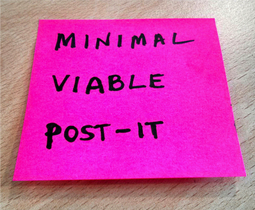Mission: Impact podcast & blog
Build a better world without becoming a martyr to your nonprofit cause
Listen on:
 photo by Mindy Johnson photo by Mindy Johnson This question helps you uncover the assumptions embedded in an idea. Often assumptions for programs and services are hidden in three key areas: audience, problem and solution. For the idea to be a good one, you need to have found the right audience, correctly identified an important problem and designed a solution that is viable. Let me give you an example. Using a design thinking approach to design new offerings for key segments of our organization’s audience, a team I led at my last association was able to design experiments that gave us feedback in each of these three key areas. Audience In one instance, we had designed a program for one audience segment. After we tested the idea with the target audience and received positive feedback, we proceeded to run a pilot. After successfully offering the program to one segment the association’s audience, we were able to replicate it for another audience. Problem Often this area is the most likely to trip you up. Have you identified a problem that is worth solving? Or a problem that is really critical for your target audience? Or is it just something that would be nice to solve? When hard choices are made about time, money and energy, this challenge gets put on the back burner. To test our understanding of the problem, we wrote a problem statement or description of what we thought the problem was. For example: “association professionals often have a clear understanding of the views of their highly engaged volunteers, but are not sure that these reflect their average member.” Through our experiments, we were able to get feedback on how important each issue was. With feedback we were able to eliminate a number of ideas that addressed problems that were not seen as critical. Solution When is the last time you got caught up in your idea and created something more elaborate than was really needed? In one case of one program we were testing with members, during the brainstorming stage, the design team had envisioned an executive leadership development program with an extensive online wrap around component. After testing and customer feedback, we learned that members were interested in the in-person aspect of the program. They doubted, however, that they would use the online components. Thus with a short testing period, we were able to eliminate a costly aspect of the program that would have be time consuming and resource intensive to create. It would have also necessitated increasing the program price, yet our research showed it did not provide sufficient value.
By testing early, getting feedback from customers we were able to learn and iterate, saving money and staff time by eliminating options that sounded promising at the white board but proved to have faulty assumptions. Want to talk about how this might apply to your organization? Request a free coaching session.  In my last post I described ‘Lean Start Up’ – a process that became popular in Silicon Valley and the business sector and now is gaining traction in the nonprofit sector. One of the key elements of lean start up is creating a ‘minimally viable product’ to use to test a new idea with customers. But how do you create a ‘minimally viable product’ for the types of programs and services that associations and nonprofits typically create? They are rarely concrete products that can easily be prototyped. There are ways to test your program and service ideas with your target audiences. They range from storyboards to explainer videos to creating a concierge version of your service. Answer the question – what is the simplest and least expensive way to test your idea? Ideally it enables you to test your idea by observing behavior. Storyboards Storyboards are essentially a ‘graphic novel’ or comic strip version of your idea. On one project I was facilitating, we used this technique to test our ideas with customers. We first had team members sketch out their idea – stick figures were just fine. This step helped team members push themselves to build out what sometimes was somewhat of a vague generic concept to delineating the concrete aspects of the program or service. We then had a professional illustrator clean up our crude sketches for testing with members. Explainer VideoAnother possibility is to create a short video that explains and illustrates your idea. Dropbox used this method to test the viability of its service. They looked at how many people watched the video and more importantly how often people forwarded the video to test enthusiasm for the idea. Simple Web Pages Create a marketing page describing your idea. Perhaps it says it is ‘coming soon.’ Include a way to sign up and get more information. See how many people opt in. Concierge Service Another alternative is to create a concierge version of your service. This is especially helpful when its full version would include automation. You build the basic marketing pages and for anyone who signs up staff process the item manually behind the scenes. Your goal is to see how many people enroll and the interest before you spend money on developing a complicated back end.
Want to talk about how you might apply this to your situation? Get in touch for a free coaching session. |
Archives
April 2024

Grace Social Sector Consulting, LLC, owns the copyright in and to all content in and transcripts of the Mission: Impact podcast, as well as the Mission: Impact blog with all rights reserved, including right of publicity.
|
Telephone301-857-9335
|
info[at]gracesocialsector.com
|
Grace Social Sector Consulting, LLC, owns the copyright in and to all content in, including transcripts and audio of the Mission: Impact podcast and all content on this website, with all rights reserved, including right of publicity.
|